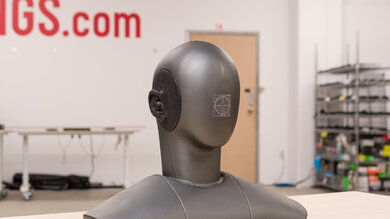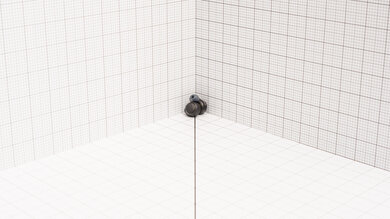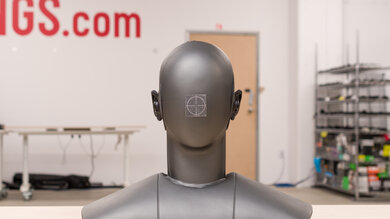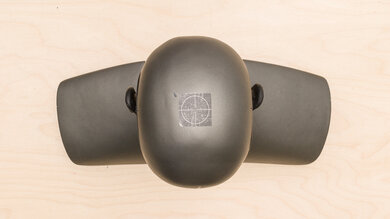The Sony WF-C500 are budget-friendly earbuds with a versatile sound that will suit most types of audio content. These sleek wireless in-ears have many customization features like 360 Reality Audio for virtual surround sound and a graphic EQ to personalize their mix via Sony's Headphones Connect companion app. While they don't have active noise cancellation (ANC), their long battery life and IPX4 rating for protection against water splashes still make them well-suited for use on the go.
Note: We noticed a hissing or white noise in our earbuds when no audio played. Several users have also reported the same issue, and while it may not affect every pair, it can get annoying over time. If you've experienced this, please let us know in the forums.
Our Verdict
The Sony WF-C500 are decent for neutral sound. Out of the box, they have a very neutral sound profile suitable for various genres. However, sibilants like S and T sounds are a bit dull. Additionally, our unit's right driver is noticeably more bass-heavy than the left, delivering a bit of extra thump and rumble to mixes. On the plus side, their companion app has a graphic EQ and presets to let you customize the mix.
- Graphic EQ and presets.
- Passive soundstage seems small and unnatural.
The Sony WF-C500 are good for commuting and travel. They struggle to passively isolate you from the sound of rumbling bus and plane engines, but they're portable and have a sturdy case to protect them when you're out and about. While their battery lasts nearly 12 hours, the case only holds one extra charge. They'll still last you through a long flight or commute.
- Long continuous battery life.
- Good build quality.
- No ANC feature.
The Sony WF-C500 are great for sports and fitness. They're portable, have a long continuous battery life, and are decently stable, so they stay in place during moderate exercise. They're also well-built and rated IPX4 for resistance against water splashes. However, they're likely to fall out during a more intense workout.
- IPX4 rating for water resistance.
- Long continuous battery life.
- Can fall out during intense workouts.
The Sony WF-C500 are satisfactory for office use. Despite not having an ANC feature, they block out a lot of office-type noise, like chatty coworkers or the hum of an A/C unit. They also have a long continuous battery life, so they'll last a typical workday without recharging. Unfortunately, they don't have multi-device pairing, and using the buttons on the side of the buds can hurt your ears.
- Long continuous battery life.
- Controls for answer/ending calls.
- No ANC feature.
- Mic has mediocre noise handling.
The Sony WF-C500 are Βluetooth-only headphones. They're compatible with Βluetooth-enabled PCs but have high latency, so you may notice a delay if you use them for gaming. They also aren't compatible with PlayStation or Xbox consoles.
The Sony WF-C500 are truly wireless headphones, and you can't use them wired.
The Sony WF-C500 are okay for phone calls. Recorded speech is clear but thin-sounding, and your voice can get drowned out if you take a call somewhere loud, like a busy street or subway station. Also, they don't have an ANC feature, so you may have trouble hearing the caller over the sound of a passing train or bus. Fortunately, they have onboard controls for answering and ending calls, so you don't need to pull out your phone.
- Controls for answer/ending calls.
- Adequate recording quality.
- No ANC feature.
- Mic has mediocre noise handling.
Changelog
- Updated May 14, 2024: We've added a comparison between these headphones and the JLab Audio JBuds 3 True Wireless in Noise Isolation.
- Updated Jun 13, 2023: We've made minor changes to the text to keep the article up to date with current review methodologies.
- Updated May 18, 2023: We've retested Continuous Battery Life in Battery, which has changed the scoring of this test.
- Updated Feb 25, 2022: Added Sony's 360 Reality Audio feature to Virtual Soundstage.
Check Price
Differences Between Sizes And Variants
The Sony WF-C500 come in four different colors: 'Βlack', 'White', 'Green', and 'Orange'. We tested them in black; you can see the label for the unit we tested here.
If you encounter another variant, please let us know in the forums, and we'll update our review.
Popular Headphones Comparisons
The Sony WF-C500 are budget-friendly headphones with a very neutral sound profile, similar to the EarFun Air Pro 2 True Wireless or the JBL Live Free NC+ TWS True Wireless. Unlike those headphones, though, they lack ANC. Also, unlike Sony's previous budget earbuds, the Sony WF-XB700 Truly Wireless, they work with the Sony Connect Ηeadphones app. It offers sound customization features and access to 360 Reality Audio, a virtual surround sound feature, although you need to subscribe to a compatible streaming service to work.
If you want more options, check out our lists of the best true wireless earbuds, the best earbuds and in-ear headphones, and the best wireless Βluetooth earbuds under $100.
The Sony WF-C500 Truly Wireless and the Sony WF-C700N Truly Wireless are extremely similar headphones. Their design and build quality are nearly identical, but the WF-C700N has active noise cancellation (ANC). This lets them cut out more background noise than the WF-C500 can passively. However, this impacts their battery life, and the WF-C700N only lasts half as long on a single charge as the WF-C500.
The Sony WF-1000XM4 Truly Wireless are better for most purposes than the Sony WF-C500 Truly Wireless. The 1000XM4 are better-built and have a much more stable fit. They also have ANC and a much better noise isolation performance. On the other hand, the C500 have a more neutral default sound profile that some may prefer. Their mic’s recording quality is also much better.
The Samsung Galaxy Buds+ are better than the Sony WF-C500 Truly Wireless for most purposes. The Samsung have a much more comfortable, stable fit and a more neutral default sound profile that some may prefer. They also have lower latency with iOS and Android devices and a mic with a much better noise handling performance. On the other hand, the Sony have a much better passive noise isolation performance and easier-to-use controls.
The Sony WF-C500 Truly Wireless are better than the Beats Studio Buds True Wireless. They have a longer continuous battery life, better overall mic performance, and better noise isolation performance. Their default sound profile is more neutral, which some may prefer, and their app includes a graphic EQ and presets for sound customization. On the other hand, the Beats are more comfortable.
Test Results

These earbuds are slightly bulky, rounded earbuds with angled silicone tips. They don't stick out from your ears as much as the Sony WF-XB700 Truly Wireless and come in more colors: 'Βlack', 'White', 'Green', and 'Orange'.
They're decently comfortable. The buds are on the bigger side, but they come with a few different options for silicone tips and don't have a deep fit. Still, depending on your ear shape, they may put a bit of pressure on your ears, and pressing the buttons on their outside surfaces can feel uncomfortable.
The controls are okay. Each bud has a big round button on its outside surface. They're easy to press, but the commands aren't very intuitive, and sometimes the buttons feel too sensitive, so you can end up double-pressing when you meant to single-press. They aren't very clicky, but on the plus side, there are voice prompts or beeps for most functions.
On the left ear:
- Short press: Raises the volume.
- Long press: Lowers the volume.
On the right ear:
- Press: Play/pauses audio.
- Double press: Skips the track forward.
- Triple press: Skips the track backward.
- Long press: Activates voice assistant.
On either earbud:
- Press one bud: Answers or ends calls.
- Long press one bud: Rejects a call.
- Long press both buds: Enters pairing mode.
These earbuds come with a good case. It's a bit smaller than the Sony WF-XB700 Truly Wireless' case and has an indicator light for the case's remaining battery life. The lid is transparent, so you can see the earbuds' battery lights when they're inside and charging. It can be hard to open, but if you drop the case, the lid stays closed. The case matches the color of the earbuds too.
These earbuds have good build quality. They're mostly made of plastic but still feel sturdy. While they don't feel as premium as the Sony WF-1000XM4 Truly Wireless, their IPX4 rating protects them against water splashes, like when running outside.
The Sony WF-C500 have a very neutral sound profile suitable for listening to most kinds of audio content. The bass range provides adequate thump and punch without overpowering the rest of the mix, while vocals and instruments sound present, clear, and detailed. Their companion app's graphic EQ and presets can help you adjust the mix if you prefer a different sound.
Unfortunately, our unit's left and right earbuds are mismatched, and the right side has noticeably more thump and rumble than the left. We also repeated our tests with different ear tip sizes to ensure the mismatch between the left and right drivers wasn't a seal or fit issue and confirmed our results with subjective listening. Our unit also produces a quiet white noise when on standby, which gets annoying over time. However, these issues may not affect every unit, meaning you may have a different experience.
Note: There's a slight discrepancy between the left and right drivers in the raw frequency response graphs due to how the files were processed. However, all other graphs are correct; this difference isn't audible to most users.
They have incredible frequency response consistency, like most in-ear headphones. Once you have a good fit with the included ear tips, you'll get consistent bass and treble delivery.
These earbuds have fantastic bass accuracy. Most of the response is flat and neutral, so mixes have the right amount of rumble, punch, and boom. However, the left and right drivers of our unit are slightly mismatched. There's some overemphasis in the low-bass range in the right earbud, so it sounds noticeably more bass-heavy than the left earbud.
These earbuds have superb mid accuracy. In songs like Smooth Operator by Sade, the saxophone and lead vocals are present and accurate throughout the song. The dip in the mid-mid nudges them slightly to the back of the mix, but they still sound clear and intense.
They have good treble accuracy. Instruments and lead vocals are present and detailed, but a bit of under-emphasis in the mid-treble makes sibilants like S and T sounds and cymbals sound slightly dull.
These earbuds have good peaks and dips performance. Our unit's right driver has a peak in the low bass that brings extra thump and rumble to mixes. There's a dip in the mid-mid that nudges instruments and lead vocals to the back of the mix, although it's much more present in the right driver of our unit. A peak in the low-treble can make some instruments sound harsh, and the uneven mid-treble makes sibilants, like cymbals, alternately piercing or dull.
Sony is known for having good quality control and ergonomics, which factors into how well a pair of headphones' L/R drivers match. That said, imaging varies between units. Our unit's drivers are well-matched in group delay, which falls below the audibility threshold. This results in tight bass and transparent treble reproduction. The L/R drivers are also well-matched in terms of amplitude and frequency response. However, the drivers are mismatched in phase response, resulting in inaccuracies in the stereo image that are audible with real-life content. Sounds in the mid-range, like voices, are perceived as off-center and louder in the right earbud.
These earbuds have a bad passive soundstage, typical for closed-back earbuds. Their sound seems to come from inside your head rather than speakers in the room around you, and the soundstage seems closed-off and small compared to most open-back headphones.
These earbuds can create a virtual soundstage via the 360 Reality Audio feature on the Sony | Headphones Connect app. This feature analyzes the shape of your ears to help make music sound like it's coming from all around you. However, a subscription to a compatible streaming service, like Tidal, Deezer, or nugs.net, is required to access this feature.
Their weighted harmonic distortion performance is good. There's some distortion present in the treble range at normal volumes. However, it's very minor and is hard to hear unless you're an astute audiophile.
These are the settings used to test the Sony WFC500. Our results are only valid when using these settings.
These earbuds have a reasonable noise isolation performance. Unlike the JLab Audio JBuds ANC 3 True Wireless, they don't have active noise cancelling (ANC) and don't block out very much bass-range noise, like rumbly bus or plane engines. They do a good job of isolating you from higher-frequency sounds, like background chit-chat and humming A/C units.
These headphones have a fantastic leakage performance. They leak very little audio at high volumes, so you don't need to worry about bothering others at the office or at home.
The integrated mic has an alright recording quality. Recorded speech is clear and bright but sounds thin and a bit distorted.
These earbuds have mediocre noise handling. In moderately loud environments, background noise is audible, but your voice is still clear and understandable. Louder background noise, like a train passing in a subway station, distorts your voice and makes it harder for the person you're calling to understand what you're saying.
The Sony WF-C500 have satisfactory battery performance. They last nearly 12 hours on a single charge, which is longer than the advertised 10-hour battery life, and will easily last you through a long work shift. That said, like the Sony WF-XB700 Truly Wireless, their case only holds one extra charge, which isn't ideal for longer trips or situations where you can't easily charge the case back up. However, you can use one earbud at a time while the other charges. Keep in mind, however, that battery life depends on your usage.
The Sony WF-C500 are compatible with the Sony Ηeadphones Connect app. There's a graphic EQ and presets that you can use to customize the sound profile, and you can set up 360 Reality Audio if you're subscribed to a compatible streaming app. You can also see the earbuds' battery life, available software updates, the codec used, and access a guide to the onboard controls. The app lacks some extra features compared to other Sony models like the Sony WF-1000XM4 Truly Wireless, though, since they don't have an auto-off timer or control remapping.
These earbuds have adequate Βluetooth connectivity performance. They can connect only with one device at a time, but they support Swift Pair and Fast Pair for easier pairing with Windows 10 and Android devices. They're compatible with Βluetooth version 5.0 and have somewhat low latency with iOS devices, so they're suitable for streaming video or watching movies on your iPhone. However, they have high latency on PC and Android devices. Some apps seem to compensate for latency differently, though.
The Sony WF-C500 are fully compatible with Βluetooth-enabled PCs. However, they can't connect to them in any other way.
The Sony WF-C500 come with a charging case that holds about one extra charge. It has no inputs except for a USΒ-C port for the charging cable, and you can't charge it wirelessly.
















